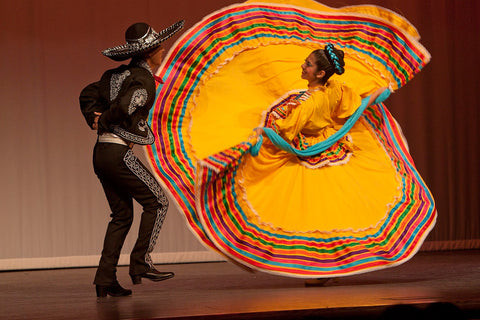Mexico’s cultural tapestry is undeniably rich and diverse, showcasing breathtaking expressions in every form imaginable. Among these vibrant elements, traditional folk dances stand out as a particularly captivating art form. For Mexicans, dance is more than just movement; it’s an activity deeply ingrained in their heritage. Since pre-Hispanic times, a vast repertoire of dances has evolved, reflecting the unique character of different regions and the fusion of indigenous, Spanish, and African influences. Today, Mexican Folk Dances, celebrated for their dazzling costumes, evocative music, and captivating choreography, are a defining aspect of Mexico’s popular culture, recognized and admired both at home and around the globe.
Mexican folk dance serves as a powerful representation of the nation’s diverse cultural traditions and, consequently, Mexico’s rich history. The historical roots of these dances are a blend of indigenous, European, and African cultural influences, each contributing to the unique character of every performance. While dance held significant importance in pre-Hispanic Mexico, many original elements of these ancient dances have been lost over time, due to factors such as Catholic evangelization and modernization. Only a few dance forms have survived relatively unchanged. Interestingly, some dances brought by the Spanish from Europe also underwent transformations within Mexico, adapting to local contexts and evolving into distinct forms. Furthermore, the African influence on Mexican dance is particularly evident in regions like Veracruz and the Costa Chica areas of Guerrero and Oaxaca, where Mexico’s Afro-Mexican population has a strong presence. Despite the pressures of modernization and social shifts, Mexican folk dance has not only endured but has also strengthened its significance since the colonial period. This resilience is partly attributed to Mexico’s enduring quest for a national identity, a sentiment that surged after the Mexican War of Independence and again following the Mexican Revolution.
You may have encountered these captivating dances at Mexican events and festivities, such as celebrations on September 15th (Independence Day), November 20th (Revolution Day), or during local civic events and patron saint festivals. For those less familiar with the world of Mexican folk dance, fear not! Read on as we delve into a brief exploration of some of the most famous Mexican dances, uncovering their traditions, costumes, symbolic representations, and the deeper meanings they convey.
At [Your Website Name], we deeply appreciate being part of this rich cultural landscape and witnessing the beauty of folkloric dances. Each element, from the elaborate wardrobes and hairstyles to the intricate braids, floral adornments, accessories, and the dynamic movements themselves, reveals a facet of Mexico’s captivating cultural heritage. Let’s immerse ourselves further in these dances as we present a curated selection of these remarkable traditions:
 Couple performing Jarabe Tapatio, a quintessential Mexican folk dance. The woman is adorned in a vibrant yellow dress, while the man is dressed in a traditional charro suit.
Couple performing Jarabe Tapatio, a quintessential Mexican folk dance. The woman is adorned in a vibrant yellow dress, while the man is dressed in a traditional charro suit.
Jarabe Tapatío, Jalisco: The Soul of Mexican Folk Dance
Jarabe Tapatío, often recognized internationally as the “Mexican Hat Dance,” is perhaps the most iconic of all Mexican traditional dances. It holds the esteemed title of “El Baile Nacional” (the national dance) of Mexico. This vibrant dance is instantly recognizable, embodying quintessential Mexican symbols like mariachis, sombreros, and gracefully flowing skirts.
Jarabe Tapatío beautifully narrates a love story through dance. During the performance, the male dancer strategically places his sombrero on the floor and performs a series of intricate steps around it, including hopping, sliding, and kicking. As the woman gracefully bends to pick up the hat, the man executes a dramatic leg kick over her head. The dance culminates in a romantic finale as the woman raises the sombrero, and both dancers momentarily conceal their faces behind it, symbolizing the sealing of their love. The costumes for this dance are equally striking. Women traditionally wear the China Poblana dress, characterized by a wide, richly embroidered skirt and a beautifully adorned blouse. Men are attired in charro suits, typically black and embellished with metallic embroidery, particularly along the legs of the pants, which are further accentuated with rows of silver buttons that highlight their movements. The music that accompanies the Jarabe Tapatío is traditionally performed by mariachis, and the dancers contribute to the rhythm with flirtatious footwork, stamping their feet on the stage to create layered percussive sounds.
Danza de los Viejitos, Michoacán: Honoring the Old Gods
This unique and endearing dance, Danza de los Viejitos (Dance of the Little Old Men), originates from the state of Michoacán, specifically the town of Jarácuaro. It has become a highly representative and celebrated folkloric dance, recognized both within Mexico and internationally.
The origins of this dance trace back to the Purepechá region in pre-Hispanic times. It is linked to rituals performed in honor of Huehuetéotl, the ancient “God of Fire” or “Old God.” Dancers would petition El Dios Viejo (The Old God) for blessings such as bountiful harvests, communication with the spirit world, and insights into the past and future. Traditionally performed by men, the dance is believed to represent the four elements: fire, water, earth, and air. It is also associated with the four colors of corn: red, yellow, white, and blue, which are significant in Mesoamerican cultures. The Danza de los Viejitos features four male dancers dressed in the traditional attire of Purépecha peasants: white blanket shirts and pants, layered with colorful serapes, and huaraches (sandals) with wooden soles that create distinctive sounds during footwork. A defining characteristic of this dance is the use of whimsical wooden masks crafted in the likeness of smiling old men, complemented by hats adorned with long, multicolored ribbons, and canes as additional props.
Danza del Venado, Sonora: A Sacred Hunt
La Danza del Venado, or Deer Dance, is predominantly performed in northwestern Mexico by the Cahita communities, specifically the Oreme (Yaqui) and Yoreme (Mayo) peoples, who inhabit the region where the states of Sonora and Sinaloa meet. This powerful dance narrates the story of the life and death of the deer, an animal considered sacred by the Yaquis and Mayos. The Deer Dance is often performed in conjunction with the Pascolas dance; although distinct, they are danced together and interwoven in certain parts of the performance.
Music plays a crucial role in Danza del Venado, setting the tone and atmosphere for the narrative. The dance commences with music played on a reed flute and a drum, initially with an uncertain, hesitant rhythm that gradually becomes firmer and more regular. The staging depicts the hunting of the deer, represented by a young, agile, slender, and strong dancer. The deer dancer’s costume is central to the performance. He wears a headdress made from a stuffed deer head, adorned with flowers or colorful ribbons, typically red. With graceful and nimble movements, the deer dancer attempts to evade the Pascolas dancers, who embody coyotes. The Pascolas wear small masks and are armed with bows and arrows. In a dramatic turn, the deer, in self-defense, “kills” one of the coyotes, who is then reincarnated as a hunter. Ultimately, the hunter fatally wounds the deer with a bow and arrow, symbolizing the death of the sacred animal.
La Bamba, Veracruz: Rhythmic Celebration from the Coast
“La Bamba” is a quintessential Mexican dance originating from the state of Veracruz. It gained international recognition through a 1958 adaptation by Ritchie Valens, which became a Top 40 hit in the U.S. charts. La Bamba belongs to the musical genre known as son jarocho and is widely considered a popular anthem of Veracruz.
The dance is typically performed on a wooden platform, known as a tarima, which amplifies the rhythmic zapateado (footwork). Dancers don the traditional jarocho costume. Men wear a guayabera (a loose-fitting linen shirt), a traditional hat, and white pants. Women are dressed in a white blouse and a flowing white skirt, characterized by its generous width and looseness, allowing for graceful movements. The lively music of La Bamba is performed by musicians playing instruments such as the jarana jarocha (a small, eight-stringed guitar) and the huapanguera (a larger, eight-stringed guitar), creating the distinctive sound of son jarocho.
Danza de los Concheros: Echoes of Ancient Rituals
The Danza de los Concheros, also known by names such as Chichimecas, Aztec, and Mexica dance, is a significant traditional dance and ceremony that has been practiced in Mexico since the early colonial period. It exhibits syncretic features, blending both pre-Hispanic and Catholic influences. This dance form is believed to be a ritual inherited from the Mexica culture, who purportedly first performed it in the 16th century as a commemoration of the battles between them and the Spanish conquistadors.
The Danza de los Concheros is intended to represent the unity of humankind with the cosmos and to establish harmony. The ceremony begins with a greeting to the four cardinal directions, symbolizing the four elements. An incense burner (a ceramic vessel used for burning incense) represents fire; a sea snail shell symbolizes wind; water is placed in a container; and the earth is represented by the ground upon which the dance is performed.
The dance visually emphasizes its pre-Hispanic roots with feathered regalia, traditional indigenous dance steps, and indigenous instruments such as huehuetl drums. The attire is characterized by vibrantly colored costumes consisting of a skirt, knee pads, wristbands, breastplate, and elaborate feather arrangements, typically in bright hues.
Concheros are considered descendants of the Mexica people. During their ceremonial dance, they attach tree seeds (ayoyote seeds) around their ankles, so the sound produced as they move imitates the sound of rain, a vital element in agricultural societies. Drums mark the rhythm for their steps, and the melody is carried by a guitar-like instrument of Spanish influence called the mandolina conchera. Today, Concheros groups are ritual dance ensembles that are not confined to any specific region. Rooted in pre-Hispanic Mexican traditions, they are associated with various religious and/or spiritual festivals and ceremonies throughout Mexico.
Today, traditional folk dances in Mexico are widely recognized as invaluable cultural heritage, garnering increasing national and international acclaim. Within Mexico and in numerous locations worldwide, countless schools, academies, and ballets are dedicated to preserving and practicing these traditional folkloric dances. While the repertoire of Mexican folk dances seems boundless, with countless regional variations, certain dances have become iconic symbols of the country on the global stage. For example, the Folkloric Ballet of Mexico, founded in 1952 by Amalia Hernández, stands as one of the most prestigious dance institutions in the nation. Conversely, some of the oldest and most traditional dances owe their continued existence to less publicized, grassroots traditions.
Although this is merely a brief overview compared to the vast panorama of regional Mexican dances, we hope it serves as an engaging introduction to the captivating beauty and cultural depth inherent in these artistic expressions. Moreover, the tradition of Mexican folk dance extends beyond Mexico’s borders; these vibrant performances can be witnessed across the world, presented with the same level of artistry, pride, and glamour that one might encounter in renowned venues like the Palacio de Bellas Artes in Mexico City.
So, we’re curious to hear from you! Have you ever had the opportunity to witness any of these dances performed live? If so, we’d love to hear about your experiences and reflections. Which traditional Mexican dance resonates most with you? Share your thoughts and feel free to suggest topics you’d like to explore in future articles!
—
Don’t forget to subscribe to our newsletter for more cultural and historical content, exclusive promotions, special offers, and first looks at new products! Stay connected with our familia of subscribers and receive articles like this and much more delivered directly to your inbox.


